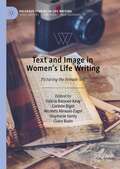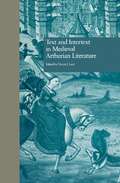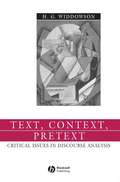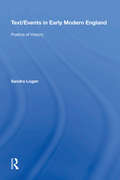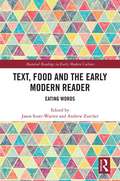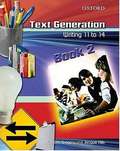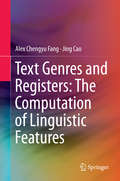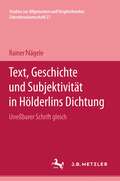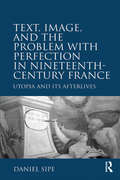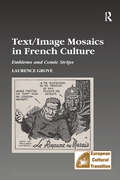- Table View
- List View
Text and Image in Women's Life Writing: Picturing the Female Self (Palgrave Studies in Life Writing)
by Valérie Baisnée-Keay Corinne Bigot Nicoleta Alexoae-Zagni Claire Bazin Stephanie GentyThis book examines the relationship between words and images in various life-writing works produced by nineteenth to twenty-first century American and British women. It addresses the politics of images in women’s life writing, contending that the presence or absence of images is often strategic. Including a range of different forms of life writing, chapters draw on traditional (auto)biographies, travel narratives, memoirs, diaries, autofiction, cancer narratives, graphic memoirs, artistic installations, quilts and online performances, as life writing moves from page to screen and other media. The book explores a wide range of women who have crossed the boundary between text and image: painters who have become writers, novelists who have become painters, writers who hesitate between images and words, models who seize the camera, and artists who use the frame as a page.
Text and Intertext in Medieval Arthurian Literature
by Norris J. LacyFirst published in 1996. Routledge is an imprint of Taylor & Francis, an informa company.
Text and Intertext in Medieval Arthurian Literature
by Norris J. LacyFirst published in 1996. Routledge is an imprint of Taylor & Francis, an informa company.
Text and Performance in Contemporary British Theatre
by Catherine LoveText and Performance in Contemporary British Theatre interrogates the paradoxical nature of theatre texts, which have been understood both as separate literary objects in their own right and as material for performance. Drawing on analysis of contemporary practitioners who are working creatively with text, the book re-examines the relationship between text and performance within the specific context of British theatre. The chapters discuss a wide range of theatre-makers creating work in the UK from the 1990s onwards, from playwrights like Tim Crouch and Jasmine Lee-Jones to companies including Action Hero and RashDash. In doing so, the book addresses issues such as theatrical authorship, artistic intention, and the apparent incompleteness of plays as both written and performed phenomena. Text and Performance in Contemporary British Theatre also explores the implications of changing technologies of page and stage, analysing the impact of recent developments in theatre-making, editing, and publishing on the status of the theatre text.Written for scholars, students, and practitioners alike, Text and Performance in Contemporary British Theatre provides an original perspective on one of the most enduring problems to occupy theatre practice and scholarship.
Text and Performance in Contemporary British Theatre
by Catherine LoveText and Performance in Contemporary British Theatre interrogates the paradoxical nature of theatre texts, which have been understood both as separate literary objects in their own right and as material for performance. Drawing on analysis of contemporary practitioners who are working creatively with text, the book re-examines the relationship between text and performance within the specific context of British theatre. The chapters discuss a wide range of theatre-makers creating work in the UK from the 1990s onwards, from playwrights like Tim Crouch and Jasmine Lee-Jones to companies including Action Hero and RashDash. In doing so, the book addresses issues such as theatrical authorship, artistic intention, and the apparent incompleteness of plays as both written and performed phenomena. Text and Performance in Contemporary British Theatre also explores the implications of changing technologies of page and stage, analysing the impact of recent developments in theatre-making, editing, and publishing on the status of the theatre text.Written for scholars, students, and practitioners alike, Text and Performance in Contemporary British Theatre provides an original perspective on one of the most enduring problems to occupy theatre practice and scholarship.
Text and Text Processing (Advances in Psychology #Volume 79)
by G. Denhiere J. P. RossiThe book presents the state-of-the-art in major aspects of text analysis and cognitive text processing by some of the most well-known European and American researchers in the field of text-linguistics and cognitive psychology. Comprehensive views and new perspectives are proposed in the following topics: cognitive and metacognitive aspects of text processing, structures and processes involved in the construction of multi-level semantic representations in relation with text and reader characteristics, achievement of local and global coherence of meaning during reading and comprehension, assessment of knowledge, knowledge acquisition of concepts and complex systems by text, and cognitive and metacognitive aspects of text production.
Text and Textuality in Early Medieval Iberia: The Written and The World, 711-1031 (Oxford Historical Monographs)
by Graham BarrettText and Textuality in Early Medieval Iberia is a study of the functions and conceptions of writing and reading, documentation and archives, and the role of literate authorities in the Christian kingdoms of the northern Iberian Peninsula between the Muslim conquest of 711 and the fall of the Islamic caliphate at Córdoba in 1031. Based on the first complete survey of the over 4,000 surviving Latin charters from the period, it is an essay in the archaeology and biography of text: part one concerns materiality, tracing the lifecycle of charters from initiation and composition to preservation and reuse, while part two addresses connectivity, delineating a network of texts through painstaking identification of more than 2,000 citations of other charters, secular and canon law, the Bible, liturgy, and monastic rules. Few may have been able to read or write, yet the extent of textuality was broad and deep, in the authority conferred upon text and the arrangements made to use it. Via charter and scribe, society and social arrangements came increasingly to be influenced by norms originating from a network of texts. By profiling the intersection and interaction of text with society and culture, Graham Barrett reconstructs textuality, how the authority of the written and the structures to access it framed and constrained actions and cultural norms, and proposes a new model of early medieval reading. As they cited other texts, charters circulated fragments of those texts; we must rethink the relationship of sources and audiences to reflect fragmentary transmission, in a textuality of imperfect knowledge.
Text and Textuality in Early Medieval Iberia: The Written and The World, 711-1031 (Oxford Historical Monographs)
by Graham BarrettText and Textuality in Early Medieval Iberia is a study of the functions and conceptions of writing and reading, documentation and archives, and the role of literate authorities in the Christian kingdoms of the northern Iberian Peninsula between the Muslim conquest of 711 and the fall of the Islamic caliphate at Córdoba in 1031. Based on the first complete survey of the over 4,000 surviving Latin charters from the period, it is an essay in the archaeology and biography of text: part one concerns materiality, tracing the lifecycle of charters from initiation and composition to preservation and reuse, while part two addresses connectivity, delineating a network of texts through painstaking identification of more than 2,000 citations of other charters, secular and canon law, the Bible, liturgy, and monastic rules. Few may have been able to read or write, yet the extent of textuality was broad and deep, in the authority conferred upon text and the arrangements made to use it. Via charter and scribe, society and social arrangements came increasingly to be influenced by norms originating from a network of texts. By profiling the intersection and interaction of text with society and culture, Graham Barrett reconstructs textuality, how the authority of the written and the structures to access it framed and constrained actions and cultural norms, and proposes a new model of early medieval reading. As they cited other texts, charters circulated fragments of those texts; we must rethink the relationship of sources and audiences to reflect fragmentary transmission, in a textuality of imperfect knowledge.
Text-Based Research and Teaching: A Social Semiotic Perspective on Language in Use
by Peter Mickan Elise LopezContributions in this book illustrate the many methods available for researching language in context and for the analysis of everyday text types. Each chapter highlights language as a resource for the expression of meanings—a social semiotic resource. Text analysis is used to reveal our capacity to formulate multiple meanings for participation in different social practices—in relationships, in work, in education and in leisure. The approach is applied in text-based teaching and in the critical analysis of public discourses. The texts come from different social spheres including banking, language classes, senate hearings, national tests and textbooks, and interior architecture. Text-based research makes a major contribution to Critical Discourse Analysis. The editors and authors of this book demonstrate the value of text analysis for awareness of the role of language for accountable citizenship and for teaching and learning. This book will be of interest to anyone researching in the fields of language learning and teaching, functional linguistics, multimodality, social semiotics, systemic functional linguistics, text-based teaching, and genre analysis, as well as literacy teachers and undergraduate and postgraduate students of linguistics, media and education.
Text, Context, Pretext: Critical Issues in Discourse Analysis (Language in Society #12)
by H. G. WiddowsonWritten by a leading researcher in the field, this fascinating examination of the relations between grammar, text, and discourse is designed to provoke critical discussion on key issues in discourse analysis which are not always clearly identified and examined. Written by a leading researcher in the field Continues the enquiry into discourse analysis that Zellig Harris initiated 50 years ago, which raised a number of problematic issues that have remained unresolved ever since Introduces the notion of pretext as an additional factor in the general interpretative process Focuses attention specifically on the work of critical discourse analysis (CDA) in light of the issues discussed
Text, Discourse and Corpora: Theory and Analysis (Corpus and Discourse)
by Michael Hoey Michaela Mahlberg Michael Stubbs Wolfgang TeubertCorpus linguistics is often regarded as a methodology in its own right, but little attention has been given to the theoretical perspectives from which the subject can be approached. The present book contributes to filling this gap. Bringing together original contributions by internationally renowned authors, the chapters include coverage of the lexical priming theory, parole-linguistics, a four-part model of language system and language use, and the concept of local textual functions. The theoretical arguments are illustrated and complemented by case studies using data from large corpora such as the BNC, smaller purpose-built corpora, and Google searches. By presenting theoretical positions in corpus linguistics, Text, Discourse, and Corpora provides an essential overview for advanced undergraduate, postgraduate and academic readers.
Text Encoding Initiative: Background and Context
by Nancy Ide Jean VéronisCharles F. Goldfarb Saratoga. California If asked for a sure recipe for chaos I would propose a I am delighted that my invention, the Standard project in which several thousand impassioned special Generalized Markup Language, was able to play a ists in scores of disciplines from a dozen or more role in the TEl's magnificent accomplishment, particu countries would be given five years to produce some larly because almost all of the original applications 1300 pages of guidelines for representing the informa of SGML were in the commercial and technological tion models of their specialties in a rigorous, machine realms. It is reasonable, of course, that organiza verifiable notation. Clearly, it would be sociologically tions with massive economic investments in new and and technologically impossible for such a group even changing information should want the benefits of infor to agree on the subject matter of such guidelines, let mation asset preservation and reuse that SGML offers. alone the coding details. But just as clearly as the It is gratifying that the TEl, representing the guardians bumblebee flies despite the laws of aerodynamics, the of humanity's oldest and most truly valuable informa Text Encoding Initiative has actually succeeded in such tion, chose SGML for those same benefits. an effort. The vaunted "information superhighway" would The TEl Guidelines are extraordinary.
Text/Events in Early Modern England: Poetics of History
by Sandra LoganEngaging with a range of events-historical moments, theatrical performances, public presentations, and courtly intrigues - and the texts that record them, this book explores representational practice as a component of Elizabethan political culture. Considering the inscriptive production of mediated, indirect experience as an authorial challenge to the value of the immediate, direct experience of events, and conversely, recognizing the multi-valent impact of theatrical performance and performativity as a reinvigoration of the immediate, this study traces the emergence of 'realness' as a textual effect and a mode of political intervention. This interactive, refractive nexus of experience and inscription comprises what Sandra Logan calls the 'text/event'. The four primary foci of this investigation - the 1558 coronation entry; the 1575 entertainments at Kenilworth; the 1590s dramatizations of the reign of Richard II; and the Essex trial of 1601 - serve as exempla of four moments in the reign of Elizabeth I which suggest an increasingly complex interaction between events and texts developing in the last half of the sixteenth century. Logan argues that, in representing England's recent and distant past, a wide range of social subjects engaged in a struggle for intellectual credibility and social viability, and in the process generated a contingent public sphere within which history, framed as a coherent narrative shaped by causal relationships, was brought to bear on the concerns of the Elizabethan present and future. Assessing how these chronicles, short prose histories, and historical dramas each made use of the materials and techniques of the others, blurring the distinctions between historiography and poetry, as well as between past and present, Logan considers the conjunctions between the development of new genres and perceptions about inscription and experience, and changing socioeconomic institutions and practices.
Text/Events in Early Modern England: Poetics of History
by Sandra LoganEngaging with a range of events-historical moments, theatrical performances, public presentations, and courtly intrigues - and the texts that record them, this book explores representational practice as a component of Elizabethan political culture. Considering the inscriptive production of mediated, indirect experience as an authorial challenge to the value of the immediate, direct experience of events, and conversely, recognizing the multi-valent impact of theatrical performance and performativity as a reinvigoration of the immediate, this study traces the emergence of 'realness' as a textual effect and a mode of political intervention. This interactive, refractive nexus of experience and inscription comprises what Sandra Logan calls the 'text/event'. The four primary foci of this investigation - the 1558 coronation entry; the 1575 entertainments at Kenilworth; the 1590s dramatizations of the reign of Richard II; and the Essex trial of 1601 - serve as exempla of four moments in the reign of Elizabeth I which suggest an increasingly complex interaction between events and texts developing in the last half of the sixteenth century. Logan argues that, in representing England's recent and distant past, a wide range of social subjects engaged in a struggle for intellectual credibility and social viability, and in the process generated a contingent public sphere within which history, framed as a coherent narrative shaped by causal relationships, was brought to bear on the concerns of the Elizabethan present and future. Assessing how these chronicles, short prose histories, and historical dramas each made use of the materials and techniques of the others, blurring the distinctions between historiography and poetry, as well as between past and present, Logan considers the conjunctions between the development of new genres and perceptions about inscription and experience, and changing socioeconomic institutions and practices.
Text, Food and the Early Modern Reader: Eating Words (Material Readings in Early Modern Culture)
by Jason Scott-Warren Andrew Elder ZurcherIn early modern culture, eating and reading were entangled acts. Our dead metaphors (swallowed stories, overcooked narratives, digested information) are all that now remains of a rich interplay between text and food, in which every element of dining, from preparation to purgation, had its equivalent in the literary sphere. Following the advice of the poet George Herbert, this essay collection "looks to the mouth", unfolding the charged relationship between ingestion and expression in a wide variety of texts and contexts. With contributions from leading scholars in the field, Text, Food and the Early Modern Reader: Eating Words fills a significant gap in our understanding of early modern cultural history. Situated at the lively intersection between literary, historical and bibliographical studies, it opens new lines of dialogue between the study of material textuality and the history of the body.
Text, Food and the Early Modern Reader: Eating Words (Material Readings in Early Modern Culture)
by Jason Scott-Warren Andrew Elder ZurcherIn early modern culture, eating and reading were entangled acts. Our dead metaphors (swallowed stories, overcooked narratives, digested information) are all that now remains of a rich interplay between text and food, in which every element of dining, from preparation to purgation, had its equivalent in the literary sphere. Following the advice of the poet George Herbert, this essay collection "looks to the mouth", unfolding the charged relationship between ingestion and expression in a wide variety of texts and contexts. With contributions from leading scholars in the field, Text, Food and the Early Modern Reader: Eating Words fills a significant gap in our understanding of early modern cultural history. Situated at the lively intersection between literary, historical and bibliographical studies, it opens new lines of dialogue between the study of material textuality and the history of the body.
Text Generation Students' Book 2 (Writing 11-14) (1st New edition) (PDF)
by France Gregory Jacquie HillsText Generation Book 2 is aimed at students in their second year of secondary school, to help raise standards in writing, which are statistically lower than reading standards and targeted as a priority area in many schools. It covers all stages of the writing process and the objectives in the Framework for Teaching English. Chapters include Changing views, Figurative language, Finding the tone, Telling tales, Poetic form, Information, Description, Analysis, Persuasive rhetoric, Persuasive logic, Advice, and Reviews. Short and longer writing tasks throughout help prepare students for National Tests ('SATs'). Chapters contain model texts, stepped activities, checklists, and plenty of variety, and are designed in a highly colourful, accessible style. Use as a scheme of work for writing, or dip in to units for inspiring texts and ideas. A unique feature - each chapter begins with a 'real writer' describing how they use the teaching points in the chapter in their own job - campaigners, poets, PC game reviewers, top novelists, all aim to motivate students to write for real audiences and purposes. Readership age: 11+.
Text Genetics in Literary Modernism and other Essays
by Hans Walter GablerThis collection of essays from world-renowned scholar Hans Walter Gabler contains writings from a decade and a half of retirement spent exploring textual criticism, genetic criticism, and literary criticism. In these sixteen stimulating contributions, he develops theories of textual criticism and editing that are inflected by our advance into the digital era; structurally analyses arts of composition in literature and music; and traces the cultural implications discernible in book design, and in the canonisation of works of literature and their authors. Distinctive and ambitious, these essays move beyond the concerns of the community of critics and scholars. Gabler responds innovatively to the issues involved and often endeavours to re-think their urgencies by bringing together the orthodox tenets of different schools of textual criticism. He moves between a variety of topics, ranging from fresh genetic approaches to the work of James Joyce and Virginia Woolf, to significant contributions to the theorisation of scholarly editing in the digital age. Written in Gabler’s fluent style, these rich and elegant compositions are essential reading for literary and textual critics, scholarly editors, readers of James Joyce, New Modernism specialists, and all those interested in textual scholarship and digital editing under the umbrella of Digital Humanities.
Text Genetics in Literary Modernism and Other Essays
by Hans Walter GablerThis collection of essays from world-renowned scholar Hans Walter Gabler contains writings from a decade and a half of retirement spent in exploration of textual criticism, genetic criticism, and literary criticism. In these sixteen stimulating contributions, he develops theories of textual criticism and editing that are inflected by our advance into the digital era; structurally analyses arts of composition in literature as well as music; and traces the cultural implications discernible in book design, and in the societal processes of the canonisation of works of literature and their authors. Distinctive and ambitious, these essays move beyond the development of concerns voiced in the community of critics and scholars. Gabler responds innovatively to the issues involved and often endeavours to re-think their urgencies through allowing orthodox tenets of national schools of textual criticism to converge and merge. He moves between a variety of topics, ranging from fresh genetic approaches to the work of James Joyce and Virginia Woolf, to significant contributions to the theorisation of scholarly editing in the digital age. Written in Gabler’s fluent style, these rich and elegant compositions are essential reading for literary and textual critics, scholarly editors, readers of James Joyce, New Modernism specialists, and all those interested in textual scholarship and digital editing within the encompassing framework of Digital Humanities.
Text Genres and Registers: The Computation Of Linguistic Features
by Chengyu Alex Fang Jing CaoThis book is a description of some of the most recent advances in text classification as part of a concerted effort to achieve computer understanding of human language. In particular, it addresses state-of-the-art developments in the computation of higher-level linguistic features, ranging from etymology to grammar and syntax for the practical task of text classification according to genres, registers and subject domains. Serving as a bridge between computational methods and sophisticated linguistic analysis, this book will be of particular interest to academics and students of computational linguistics as well as professionals in natural language engineering.
Text, Geschichte und Subjektivität in Hölderlins Dichtung: Studien zur Allgemeinen und Vergleichenden Literaturwissenschaft, Band 27
by Rainer NägeleText, Image, and the Problem with Perfection in Nineteenth-Century France: Utopia and Its Afterlives
by Daniel SipeIn the decades after the French Revolution, philosophers, artists, and social scientists set out to chart and build a way to a new world and their speculative blueprints circulated like banknotes in a parallel economy of ideas. Examining representations of ideal societies in nineteenth-century French culture, Daniel Sipe argues that the dream-image of the literary or art-historical utopia does not disappear but rather is profoundly altered by its proximity to the social utopianism of the day. Sipe focuses on this persistent afterlife in utopias ranging from François-René de Chateaubriand’s Amerindian utopia in Atala (1801) to the utopian spoof of J.J. Grandville’s illustrated novel Un autre monde (1844). He proposes a new reading of Etienne Cabet’s seminal utopian novel, Voyage en Icarie (1840) and offers an original perspective on the gendered utopias of technological inspiration that authors such as Charles Barbara and Auguste Villiers de l’Isle-Adam penned in the second half of the century. In addition, Sipe considers utopias or important readings of the century’s rampant utopianism in, among others, Victor Hugo, Alfred de Vigny, Théophile Gautier, Charles Baudelaire, and Gustave Courbet. His book provides the historical context for comprehending the significance and implications of this enigmatic afterlife in nineteenth-century utopian art and literature.
Text, Image, and the Problem with Perfection in Nineteenth-Century France: Utopia and Its Afterlives
by Daniel SipeIn the decades after the French Revolution, philosophers, artists, and social scientists set out to chart and build a way to a new world and their speculative blueprints circulated like banknotes in a parallel economy of ideas. Examining representations of ideal societies in nineteenth-century French culture, Daniel Sipe argues that the dream-image of the literary or art-historical utopia does not disappear but rather is profoundly altered by its proximity to the social utopianism of the day. Sipe focuses on this persistent afterlife in utopias ranging from François-René de Chateaubriand’s Amerindian utopia in Atala (1801) to the utopian spoof of J.J. Grandville’s illustrated novel Un autre monde (1844). He proposes a new reading of Etienne Cabet’s seminal utopian novel, Voyage en Icarie (1840) and offers an original perspective on the gendered utopias of technological inspiration that authors such as Charles Barbara and Auguste Villiers de l’Isle-Adam penned in the second half of the century. In addition, Sipe considers utopias or important readings of the century’s rampant utopianism in, among others, Victor Hugo, Alfred de Vigny, Théophile Gautier, Charles Baudelaire, and Gustave Courbet. His book provides the historical context for comprehending the significance and implications of this enigmatic afterlife in nineteenth-century utopian art and literature.
Text/Image Mosaics in French Culture: Emblems and Comic Strips (Studies in European Cultural Transition)
by Laurance GroveThis study compares text/image interaction as manifested in emblem books (and related forms) and the modern bande dessinée, or French-language comic strip. It moves beyond the issue of defining the emblematic genre to examine the ways in which emblems - and their modern counterparts - interact with the surrounding culture, and what they disclose about that culture. Drawing largely on primary material from the Bibliothèque nationale de France and from Glasgow University Library's Stirling Maxwell Collection of emblem literature, Laurence Grove builds on the ideas of Marshall McLuhan, Elizabeth Eisenstein and, more recently, Neil Rhodes and Jonathan Sawday. Divided into four sections-Theoretics, Production, Thematics and Reception-Text/Image Mosaics in French Culture broaches topics such as theoretical approaches (past and present) to text/image forms, the question of narrative within the scope of text/image creations, and the reuse of visual iconography for diametrically opposed political or religious purposes. The author argues that, despite the gap in time between the advent of emblems and that of comic strips, the two forms are analogous, in that both are the products of a 'parallel mentality'. The mindsets of the periods that popularised these forms have certain common features related to repeated social conditions rather than to the pure evolution over time. Grove's analysis and historical contextualisation of that mentality provide insight into our own popular culture forms, not only the comic strip but also other hybrid media such as advertising and the Internet. His juxtaposition of emblems and the bande dessinée increases our understanding of all such combinations of picture and text.
Text/Image Mosaics in French Culture: Emblems and Comic Strips (Studies in European Cultural Transition)
by Laurance GroveThis study compares text/image interaction as manifested in emblem books (and related forms) and the modern bande dessinée, or French-language comic strip. It moves beyond the issue of defining the emblematic genre to examine the ways in which emblems - and their modern counterparts - interact with the surrounding culture, and what they disclose about that culture. Drawing largely on primary material from the Bibliothèque nationale de France and from Glasgow University Library's Stirling Maxwell Collection of emblem literature, Laurence Grove builds on the ideas of Marshall McLuhan, Elizabeth Eisenstein and, more recently, Neil Rhodes and Jonathan Sawday. Divided into four sections-Theoretics, Production, Thematics and Reception-Text/Image Mosaics in French Culture broaches topics such as theoretical approaches (past and present) to text/image forms, the question of narrative within the scope of text/image creations, and the reuse of visual iconography for diametrically opposed political or religious purposes. The author argues that, despite the gap in time between the advent of emblems and that of comic strips, the two forms are analogous, in that both are the products of a 'parallel mentality'. The mindsets of the periods that popularised these forms have certain common features related to repeated social conditions rather than to the pure evolution over time. Grove's analysis and historical contextualisation of that mentality provide insight into our own popular culture forms, not only the comic strip but also other hybrid media such as advertising and the Internet. His juxtaposition of emblems and the bande dessinée increases our understanding of all such combinations of picture and text.
